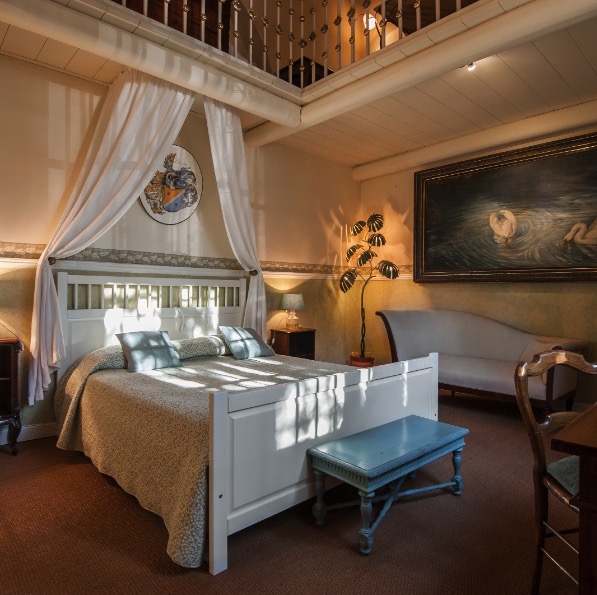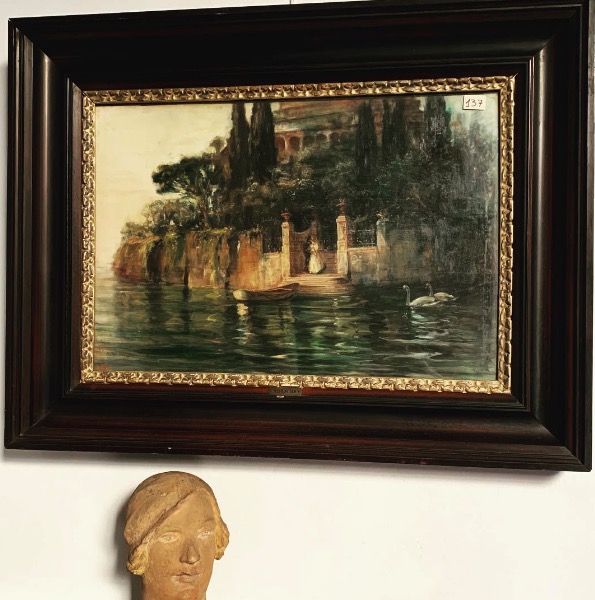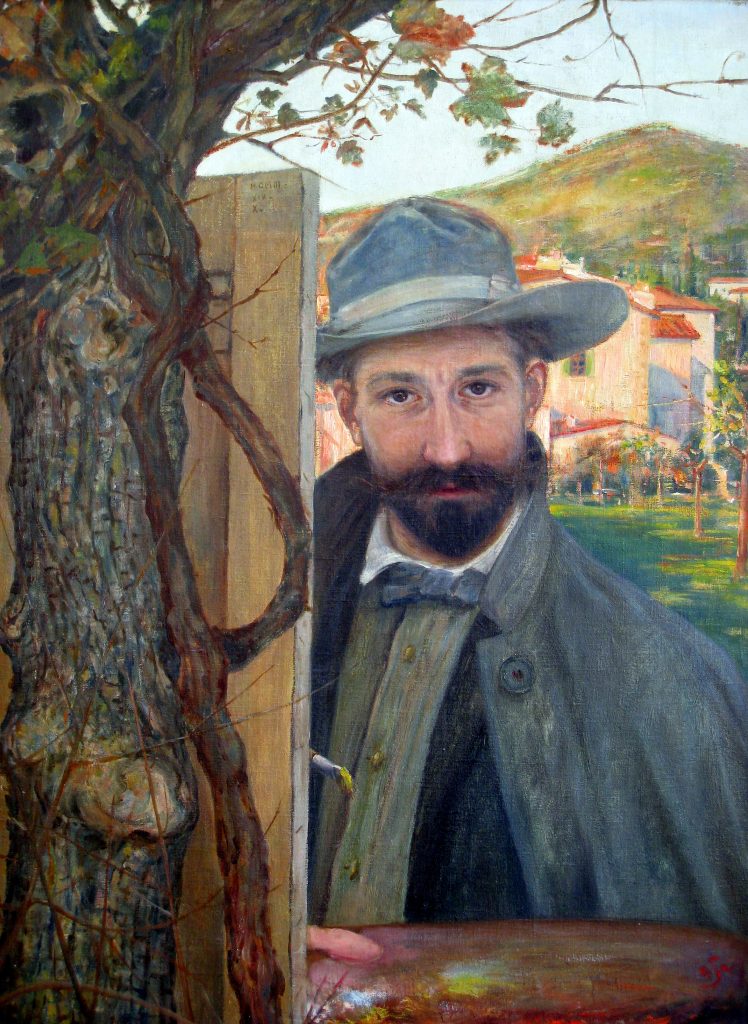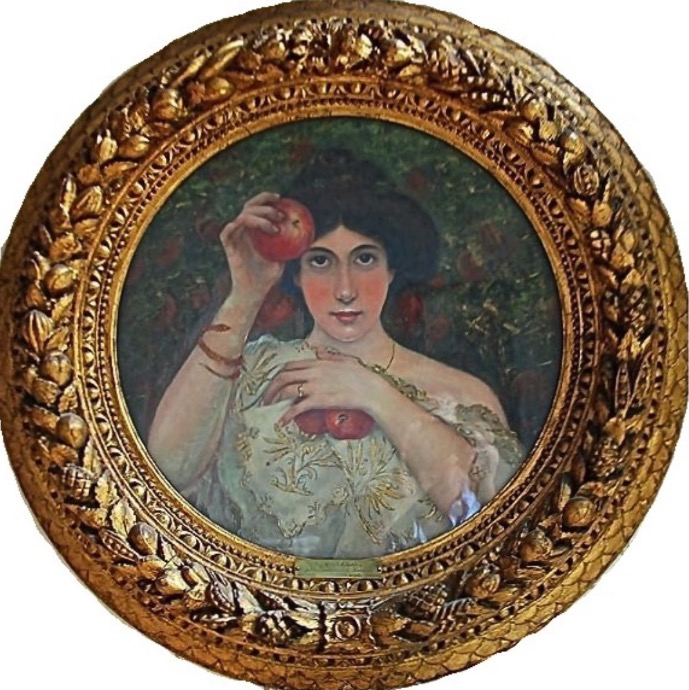One of the most magical things about living in Florence is that it will never cease to surprise you, no matter how long you live here. I had one of these unexpected surprises recently on discovering Casa Schlatter, the museum that was once the home and atelier of the eclectic artist and theosophist, Carlo Adolfo Schlatter. It is known as the “house with dragons on the roof”; the latter were forged by the artist to stand guard over the artistic treasures within its walls. When he turned 21, Schlatter requested and obtained his inheritance, with which he built the dwelling towards the end of the 1800s. It was the first construction on what was then viale Militare (now viale del Mille #14), in the countryside on the outskirts of town. Since opening in 2021, this home-atelier museum has housed a collection of about 350 of Schlatter’s paintings, the frames for which he made himself, as well as his refined engravings, books, 23 handwritten and illustrated manuscripts, sculptures and artisan objects.


Born in Rome in 1873, Carlo Adolfo Schlatter was the son of a Swiss consul to the Holy See, whose family dated back to the 13th century. After his father’s bank suffered a setback and his property within the Vatican was confiscated following the breach of Porta Pia on September 20, 1870 (when the Papal States under Pope Pius IX were defeated and the Italian States, except for San Marino were finally unified under the Kingdom of Italy), the family took refuge in Florence. Schlatter studied art and, in the early years, took part in exhibitions, such as Turin’s Esposizione Nazionale di Belle Arti in 1880, Florence’s Festa dell’Arte e dei Fiori in 1896 and the Brera Biennale, where King Vittorio Emanuele III and the King of Siam both acquired his works. Between 1897 and 1901, Schlatter also took courses at the Scuola Libera del Nudo of the Florentine Fine Arts Academy, where he met Ardengo Soffici, while other artists like Galileo Chini and Arnold Böcklin were enrolled there. Throughout his life, his approach to the canvas was influenced by various artistic movements, ranging from the Macchiaioli, especially their affinity with nature, to Symbolism and German Romanticism until arriving at the Naïve.
Over the centuries, the Schlatter family always had a close relationship with religion, in particular with the Swiss Protestant Church. Schlatter also developed a keen interest in spirituality, which caused him to join the Florentine Theosophical Society. He became a scholar and wrote copiously about theosophy and philosophy, in addition to being fascinated by esotericism, numerology, oriental studies and mysticism. In fact, each of his paintings hides a spiritual or secret meaning for the viewer to discover. These metaphysical views were also reflected in Schlatter’s idea of the ethical role of the artist, resulting in a refusal to sell his artworks for pecuniary gain, which is perhaps one of the reasons why his name is not as well-known as it deserves to be. He believed so strongly in this that he left the following instructions in his will: “But you must consider only the moral value [of a painting] and preserve it with care to be shown to whomever can gain a spiritual benefit from it.”


In his private life, Schlatter had one great love, his wife, Emma Moni, the mother of his son, Alfredo. As you enter the house museum, you see Emma’s portrait titled Nuova Eva hanging on the wall in a circular frame. It is one of only two female portraits he painted. The daughter of a high-ranking military officer, Emma’s family was not enthusiastic about her marrying an impecunious artist. When her father died, he disinherited her. Although Schlatter never sold any of his paintings, he managed to maintain his family, despite occasional difficulties, because he was also a talented artisan and he was willing to sell the fruits of this labor. He worked in wrought iron, stained glass and semi-precious stones, and even painted copies of famous paintings that were commissioned for sale to tourists.
After Emma died in 1923, he became a familiar sight to locals. Every day, after he had showered in cold water, he dressed in his Russian-style shirts and sandals, without a coat, and walked in all weathers to the Allori cemetery in Galluzzo to visit his wife’s grave. After his death in 1958, he was laid to rest alongside her.
Since 2010, the custodian of Carlo Adolfo Schlatter’s legacy has been his great-granddaughter, Alessandra Schlatter. She began by restoring the house and turning three of the rooms into a charming bed and breakfast. In 2013, she donated an archive of Schlatter’s papers and photography to the Gabinetto Vieusseux, which was accepted in 2015. In 2017, the University of Florence photographed and catalogued the artist’s works. Talks, concerts and plays are often held at the house museum. In 2019, Alessandra established the APS Casa Museo Schlatter Foundation as a first step towards recognition as a museum for locals and internationals. In the meantime, be sure to make an appointment to see this house museum. You won’t regret it.








